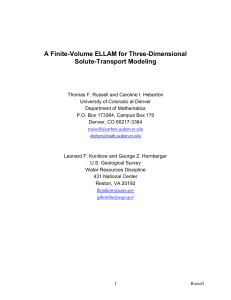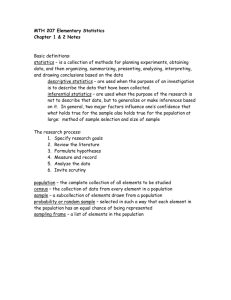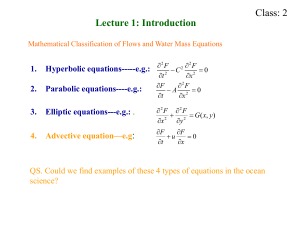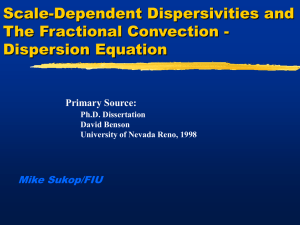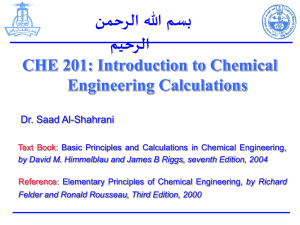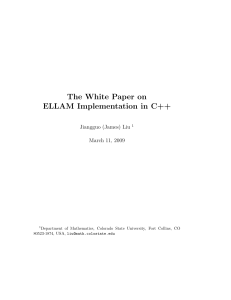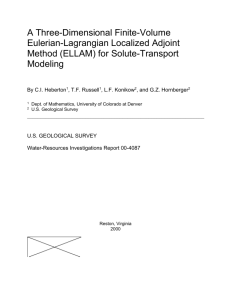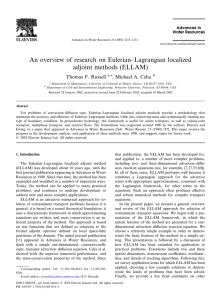Solving the Three-Dimensional Solute
advertisement
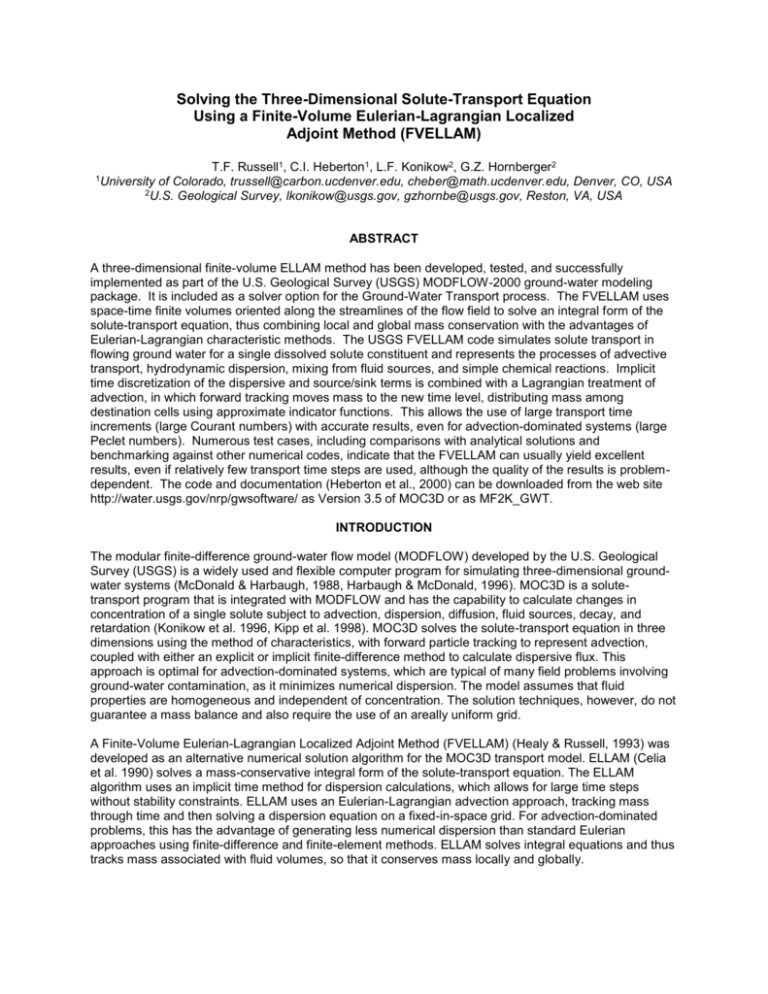
Solving the Three-Dimensional Solute-Transport Equation Using a Finite-Volume Eulerian-Lagrangian Localized Adjoint Method (FVELLAM) T.F. Russell1, C.I. Heberton1, L.F. Konikow2, G.Z. Hornberger2 of Colorado, trussell@carbon.ucdenver.edu, cheber@math.ucdenver.edu, Denver, CO, USA 2U.S. Geological Survey, lkonikow@usgs.gov, gzhornbe@usgs.gov, Reston, VA, USA 1University ABSTRACT A three-dimensional finite-volume ELLAM method has been developed, tested, and successfully implemented as part of the U.S. Geological Survey (USGS) MODFLOW-2000 ground-water modeling package. It is included as a solver option for the Ground-Water Transport process. The FVELLAM uses space-time finite volumes oriented along the streamlines of the flow field to solve an integral form of the solute-transport equation, thus combining local and global mass conservation with the advantages of Eulerian-Lagrangian characteristic methods. The USGS FVELLAM code simulates solute transport in flowing ground water for a single dissolved solute constituent and represents the processes of advective transport, hydrodynamic dispersion, mixing from fluid sources, and simple chemical reactions. Implicit time discretization of the dispersive and source/sink terms is combined with a Lagrangian treatment of advection, in which forward tracking moves mass to the new time level, distributing mass among destination cells using approximate indicator functions. This allows the use of large transport time increments (large Courant numbers) with accurate results, even for advection-dominated systems (large Peclet numbers). Numerous test cases, including comparisons with analytical solutions and benchmarking against other numerical codes, indicate that the FVELLAM can usually yield excellent results, even if relatively few transport time steps are used, although the quality of the results is problemdependent. The code and documentation (Heberton et al., 2000) can be downloaded from the web site http://water.usgs.gov/nrp/gwsoftware/ as Version 3.5 of MOC3D or as MF2K_GWT. INTRODUCTION The modular finite-difference ground-water flow model (MODFLOW) developed by the U.S. Geological Survey (USGS) is a widely used and flexible computer program for simulating three-dimensional groundwater systems (McDonald & Harbaugh, 1988, Harbaugh & McDonald, 1996). MOC3D is a solutetransport program that is integrated with MODFLOW and has the capability to calculate changes in concentration of a single solute subject to advection, dispersion, diffusion, fluid sources, decay, and retardation (Konikow et al. 1996, Kipp et al. 1998). MOC3D solves the solute-transport equation in three dimensions using the method of characteristics, with forward particle tracking to represent advection, coupled with either an explicit or implicit finite-difference method to calculate dispersive flux. This approach is optimal for advection-dominated systems, which are typical of many field problems involving ground-water contamination, as it minimizes numerical dispersion. The model assumes that fluid properties are homogeneous and independent of concentration. The solution techniques, however, do not guarantee a mass balance and also require the use of an areally uniform grid. A Finite-Volume Eulerian-Lagrangian Localized Adjoint Method (FVELLAM) (Healy & Russell, 1993) was developed as an alternative numerical solution algorithm for the MOC3D transport model. ELLAM (Celia et al. 1990) solves a mass-conservative integral form of the solute-transport equation. The ELLAM algorithm uses an implicit time method for dispersion calculations, which allows for large time steps without stability constraints. ELLAM uses an Eulerian-Lagrangian advection approach, tracking mass through time and then solving a dispersion equation on a fixed-in-space grid. For advection-dominated problems, this has the advantage of generating less numerical dispersion than standard Eulerian approaches using finite-difference and finite-element methods. ELLAM solves integral equations and thus tracks mass associated with fluid volumes, so that it conserves mass locally and globally. GOVERNING EQUATIONS The ground-water flow, interstitial velocity, and solute-transport equations used in MOC3D are given by Konikow et al. (1996). Solution to the flow equation provides the interstitial velocity field, which couples the solute-transport equation to the ground-water flow equation. The governing equation for this finite-volume approach is an integral form of the solute-transport equation, which is a statement of conservation of mass over the domain of integration. Integration against a “test function” (u) provides the formulation of conservation of mass, including treatment of cell or subdomain boundary conditions and solute decay. The test function effectively specifies the domain of integration for the transport equation by the portion of the space-time domain where its value is nonzero. If we multiply the solute-transport equation by the test function u and integrate over time and space, we have: T 0 C u u CV DC u t R Rf f CW u Cdtdx 0 (1) where is the entire spatial transport subdomain, T is the end of the simulation time period starting at time zero, is the effective porosity (dimensionless), C is volumetric concentration (mass of solute per unit volume of fluid, ML-3), t is time (T), Rf is the retardation factor, V is the interstitial fluid velocity (LT -1), D is a second-rank tensor of dispersion coefficients (L2T-1), W is a volumetric fluid sink or source rate per unit volume of aquifer (T-1), C is the volumetric concentration in the sink/source fluid (ML-3) (if W represents a sink, C = C), and is the decay rate (T-1). The Eulerian-Lagrangian aspects of the method derive from the requirement that the test function satisfy the adjoint equation, u V u u 0 . t R f (2) Thus, for the time step from tn to tn+1, ux,t f x,t e t n1 t , (3) where f V f 0 , t R f (4) so that f is constant along characteristics of the retarded interstitial velocity field. With (t n 1 t) ue , (5) (that is, f = 1) we arrive at a statement of global conservation of mass for a time step. For a local conservation equation on each finite-difference cell l in the transport subdomain, let ul x,t fl x,t e t n1 t where fl(x,tn+1) = 1 on , l and fl(x,tn+1) = 0 elsewhere: (6) C l e t dx Rf supp ul n 1 n 1 n 1 t n 1 tn supp ul t CV DC ndtds n 1 n 1 e t t e t t DC ndtds C W dtdx Rf R f supp ul suppW (7) e t * C dx n l where signifies the spatial boundary of the argument; supp denotes the support of a function (that is, the part of its domain where a function assumes a non-zero value); n is the unit outward normal vector on the specified boundary; l is the part of the spatial domain holding mass at time tn for destination cell at time tn+1 under advection; n+1 (tn,tn+1) is the space-time boundary at time step n+1; and l dx and ds signify differential volume and area, respectively. Note that (7) appears as space-time integrals of the dispersion equations. ELLAM can be viewed as a method of characteristics, tracking mass along streamlines of the flow to accumulate data to the right-hand side of the system of equations. NUMERICAL METHODS ELLAM Overview A numerical solution of the three-dimensional ground-water flow equation is obtained by the MODFLOW code using implicit (backward-in-time) finite-difference methods. After the head distribution has been calculated for a given time step or steady-state flow condition, the specific discharge across every face of each finite-difference cell within the transport subdomain is calculated using a finite-difference approximation (see Konikow et al. 1996). The seepage velocity is calculated at points within a finitedifference cell based on linearly interpolated estimates of specific discharge at those points divided by the effective porosity of the cell (see Konikow et al. 1996). Advection in flowing ground water is then simulated by mass tracking along the characteristic curves determined by the seepage velocity, using the specific discharges computed at the end of the flow time step. As in MOC3D, tracking is performed using linear interpolation of velocity in the direction of the component of interest and piecewise-constant interpolation in the other two directions. The approach is to solve a system of three ordinary differential equations to find the characteristic curves [x = x(t), y = y(t), and z = z(t)] along which fluid is advected. This is accomplished by introducing a set of moving points that can be traced within the stationary coordinates of a finite-difference grid. Each point corresponds to one characteristic curve, and values of x, y, and z are obtained as functions of t for each characteristic (Garder et al. 1964). Each point moves through the flow field at a rate governed by the flow velocity acting along its trajectory. The ELLAM equations suggest that mass is backtracked along characteristics to the pre-image of each cell or boundary face. It is not possible, however, to exactly locate all of the mass at the old time level by backtracking a finite number of points. In order to achieve mass balance, this implementation tracks the known mass distribution forward from the old to the new time level. In this numerical forward tracking, each cell is divided into subcells, where the parameters NSC, NSR, NSL specify the number of subdivisions in the column, row, and layer direction, respectively. A moving point starts at the center of each subcell at time level n. Depending on where the point lands at the new time, the subcell mass may be distributed among cells neighboring the destination cell using “approximate test functions,” wl, that add up to 1. This distribution prevents small velocity perturbations from causing large changes in concentration. This yields the formulation of the time step n term in (7), e t * C n dx e t l x j yi b j ,i ,k NSC NSRNSL w p C p j ,i ,k p=subcell center f l n (8) where summation runs through all subcells of each cell in the transport subdomain, b is the cell thickness, and pf is the image of p under forward tracking to the new time level. The first term in (7) is evaluated with the trapezoidal rule on each cell octant. Concentrations at octant corners are weighted averages of neighboring node concentrations, determined by trilinear interpolation. The third (dispersion) term involves centered differences as in MOC3D (Konikow et al., 1996), modified for varying grid dimensions. In the fourth term, a source or sink is distributed uniformly over the cell containing it. For a source cell, a time step is discretized into a number NT of sub-time steps, integrating in time with the composite trapezoidal rule. Source mass is tracked within the transport subgrid, just like mass that began the time step in the system, but starting at the sub-step when it enters the system. Sink concentration is assumed to be the average nodal concentration for the transport time step, except in the case of a sink due to evapotranspiration, where it is taken to be zero. Integration rules are midpoint in space and a one point backward Euler in time. At the boundary, like previous versions of MOC3D, this ELLAM implementation approximates total solute flux by the advective flux (not required by ELLAM in general). Thus, boundary-face concentrations are not coupled to cell-center concentrations through the numerical derivative. Mass tracked across outflow boundaries provides data for a system of outflow boundary equations decoupled from the cell equations. User-input inflow concentrations together with the outflow solutions then accumulate on the right-hand side of the system of cell equations. An inflow boundary is treated in a manner similar to a source, with sub-time steps. For details of the numerical formulation, see Heberton et al. (2000). Accuracy criteria For advective transport, at least four grid nodes across a solute front (or zone of relatively steep concentration gradient) are needed for good accuracy. Hence, the profile of a concentration peak should be represented across at least eight nodes of the grid for good accuracy. In such test results, a peak concentration can be advected with very small dissipation per time step of the maximum for a variety of Courant numbers. With insufficient mesh, a peak will decay rapidly for an initial period of time as it spreads and oscillates; thereafter, the numerical decay is very slow and the oscillations do not worsen. A fine discretization of tracked mass (large NSC, NSR, NSL) reduces the rate of peak decay when modeling with many transport time steps. Regardless of the solution accuracy, global mass is conserved. Dispersion accuracy is governed in part by the central-difference approximations to the space derivatives; a finer mesh is more accurate. The implicit time-stepping is unconditionally stable. This allows for large time steps during the simulation. Because ELLAM solves the dispersion equation along characteristics, thus avoiding large values of time derivatives of the solution at passage of a steep front, temporal errors are small compared to a standard finite-difference solution to an advection-diffusion equation, and large, accurate, stable time steps are possible, though the accuracy of the solution to the dispersion equation still decreases as the time step size increases. However, smaller time steps in order to reduce this error could result in a loss of peak to interpolations performed at each advective step, an effect that can be reduced by increasing NSC, NSR, and NSL. One additional difficulty encountered with implicit temporal differencing results from the use of a symmetric spatial differencing for the cross-product terms of the dispersion tensor. This creates a potential for overshoot and undershoot in the calculated concentration solution, particularly when the velocity field is oblique to the axes of the grid. A remedy for excessive overshoot and undershoot is to refine the finite-difference mesh. This may, however, increase simulation times. MODEL TESTING AND EVALUATION The ELLAM simulator was tested and evaluated by running a suite of test cases (see Konikow et al. 1996, Kipp et al. 1998). This suite includes base results generated by analytical solutions and by other numerical models. It spans a range of conditions and problem types so that the user will gain an appreciation for both the strengths and weaknesses of this particular code. All test cases involve steady- state flow conditions. For brevity, we present only one case here; others involving 1-D flow, 2-D radial flow, a point initial condition in 3-D uniform flow, and a constant source in 2-D and 3-D nonuniform flow can be found in Heberton et al. (2000). Uniform Flow, Three-Dimensional Transport To evaluate and test ELLAM for three-dimensional cases, we compared numerical results with those of the analytical solution developed by Wexler (1992) for the case of three-dimensional solute transport from a continuous point source in a steady, uniform flow field in a homogeneous aquifer of infinite extent. Konikow et al. (1996) note that this evaluation primarily is a test of the accuracy of the calculated dispersive flux in three directions because the flow field is aligned with the grid. The problem and analytical solution are described in detail by Konikow et al. (1996, p. 45-48); the parameters and Parameter Txx = Tyy L TH TV Value 0.0125 m2/day 0.25 0.6 m 0.03 m 0.006 m Vy 0.1 m/day Vx = Vz 0.0 m/day Initial concentration (C0) 0.0 Source concentration ( C) Q (at well) 2.5 106 g/m3 1.0 10-6 m3/d Source location Column = 1, Row = 8, Layer = 1 Number of rows 30 Number of columns 12 Number of layers 40 DELR (x) 0.5 m DELC (y) boundary conditions for this test case are summarized in Table 1. This case also represents a test of the ability of the algorithm to represent the effects of a solute source at a specified flux boundary condition. 3.0 m Layer thickness (z) 0.05 m CELDIS 1.0 Table 1. Base-case parameters used in ELLAM simulation of transport from a continuous point source in a threedimensional, uniform, steady-state flow system The results of ELLAM are compared graphically in Figure 1 with those of the analytical solution for the x-y plane passing through the point source. Figure 1a shows the concentrations in this plane at t = 400 days as calculated using the analytical solution. Also shown, in Figures 1b-d, are the ELLAM solutions using CELDIS = 7 (two transport time increments), NSC = NSR = NSL = 4, and NT = 16 (Figure 1b); CELDIS = 1 (14 time increments), NSC = NSR = NSL = 4, and NT = 4 (Figure 1c); and CELDIS = 0.1 (134 time increments), NSC = NSL = 4, NSR = 8, and NT = 16 (Figure 1d). As noted in previous MOC3D reports, a slightly greater spreading is evident in the numerical model results than in the analytical solution, both upstream as well as downstream of the source. Part of this difference, however, is explained by the fact that the numerical source is applied over a finite area in the horizontal plane of the model, in which the length of the source cell is 3 m in the direction parallel to flow, whereas the source is represented as a true point in the analytical solution. The ELLAM results using two transport time increments (Figure 1b) indicate that more time steps are needed in order to accurately simulate dispersion. Obtaining any reasonable result at all with such large time steps is a strength of ELLAM. The ELLAM results for 14 time steps (Figure 1c) accurately characterize the dispersive flux without the spreading upstream from the source that is produced by MOC3D. The ELLAM results for 134 time steps (Figure 1d) yield even less spreading upstream of the source, but do exhibit numerical oscillations produced because the concentration gradient is too steep relative to the grid spacing. Konikow et al. (1996) also present comparisons for this case for vertical planes parallel and perpendicular to the flow direction. These same comparisons between the analytical and ELLAM results are as close as between Figures 1a and 1c, and are not reproduced here. RELATIVE COMPUTATIONAL AND STORAGE EFFICIENCY Computer-memory storage requirements for ELLAM are greater than those for the explicit or implicit MOC3D dispersive transport algorithm. The additional arrays required can increase the memory size requirement by as much as a factor of three. The computational effort required by the ELLAM simulator is strongly dependent on the size of the problem being solved, as determined by the total number of nodes, the NS and NT values, and the total number of time increments. Analyses indicate that the greatest computational effort, as measured by CPU time, is typically expended in the mass tracking routines, which can be parallelized (not done here). For a given problem, computational time may vary significantly as a function of the characteristics of the Figure 1. Concentration contours for (a) analytical and (b-d) ELLAM solutions in horizontal plane containing solute source (layer 1) for 3-D solute transport in a uniform steady flow field at t = 400 days. Parameters defined in Table 1. particular computer on which the simulation is performed, and on which FORTRAN compiler and options were used to generate the executable code. CONCLUSIONS The accuracy and precision of the numerical results of the implicit ELLAM simulator were tested and evaluated by comparison to analytical and numerical solutions for the same set of test problems as documented previously for MOC3D, although the instantaneous point source problem was modified slightly. These evaluation tests indicate that the solution algorithms in the ELLAM model can successfully and accurately simulate three-dimensional transport and dispersion of a solute in flowing ground water. The numerical methods used to solve the governing equations have broad general capability and flexibility for application to a wide range of hydrogeological problems. To avoid non-physical oscillations and loss of peak concentrations, care must be taken to use a grid having sufficient mesh density to adequately resolve sharp fronts. Relative to the method of characteristics, the primary advantages of the ELLAM code are that fewer transport time steps need be used and that mass is conserved globally, and relative to other standard numerical methods, it minimizes numerical dispersion in advection-dominated systems. Using ELLAM with few time steps can provide an accurate and cost-effective way of discerning salient features of the solute-transport process under a complex given set of boundary conditions. Furthermore, the ELLAM algorithm eliminates the previous restriction in MOC3D that the transport grid had to be uniformly spaced. ACKNOWLEDGMENTS The authors appreciate the helpful model evaluation and review comments provided by USGS colleagues R.W. Healy, K.L. Kipp, D.M. Diodato, and A.M. Shapiro. The research of the second author was supported in part by National Science Foundation Grant Nos. DMS-9706866 and DMS-0084438 and Army Research Office Grant No. 37119-GS-AAS. REFERENCES Celia, M.A., Russell, T.F., Herrera, I., and Ewing, R.E., 1990. An Eulerian-Lagrangian localized adjoint method for the advection-diffusion equation. Advances in Water Resources 13(4), 187-206. Garder, A.O., Peaceman, D.W., and Pozzi, A.L., 1964. Numerical calculation of multidimensional miscible displacement by the method of characteristics. Soc. Petroleum Eng. Jour. 4(1), 26-36. Harbaugh, A.W., and McDonald, M.G., 1996. User's documentation for MODFLOW-96, an update to the U.S. Geological Survey modular finite-difference ground-water flow model, U.S. Geological Survey Open-File Report 96-485, 56 p. Healy, R.W., and Russell, T.F., 1993. A finite-volume Eulerian-Lagrangian localized adjoint method for solution of the advection-dispersion equation. Water Resources Research 29(7), 2399-2413. Heberton, C.I., Russell, T.F., Konikow, L.F., and Hornberger, G.Z., 2000. A three-dimensional finitevolume Eulerian-Lagrangian localized adjoint method (ELLAM) for solute transport modeling, U.S. Geological Survey Water-Resources Investigations Report 00-4087, 63 p. Kipp, K.L., Konikow, L.F., and Hornberger, G.Z., 1998. An implicit dispersive transport algorithm for the U.S. Geological Survey MOC3D solute-transport model, U.S. Geological Survey WaterResources Investigations Report 98-4234, 54 p. Konikow, L.F., Goode, D.J., and Hornberger, G.Z., 1996. A three-dimensional method-of-characteristics solute-transport model (MOC3D), U.S. Geological Survey Water-Resources Investigations Report 96-4267, 87 p. McDonald, M.G., and Harbaugh, A.W., 1988. A modular three-dimensional finite-difference ground-water flow model, U.S. Geological Survey Techniques of Water-Resources Investigations, Book 6, Chapter A1, 586 p. Wexler, E.J., 1992. Analytical solutions for one-, two-, and three-dimensional solute transport in groundwater systems with uniform flow, U.S. Geological Survey Techniques of Water-Resources Investigations, Book 3, Chapter B7, 190 p.


